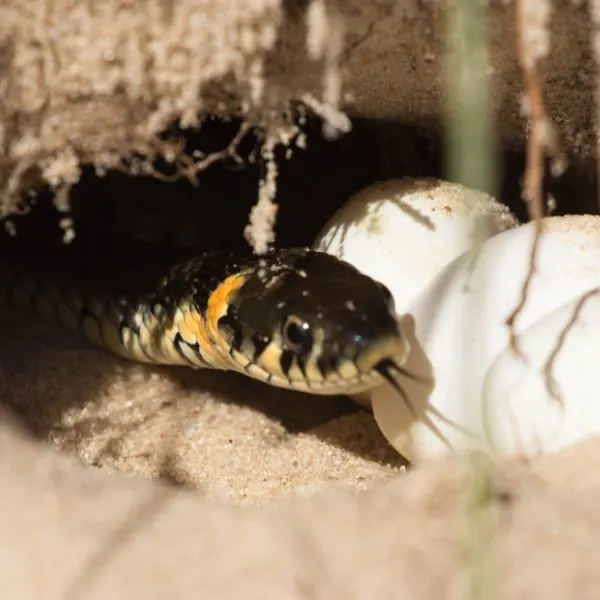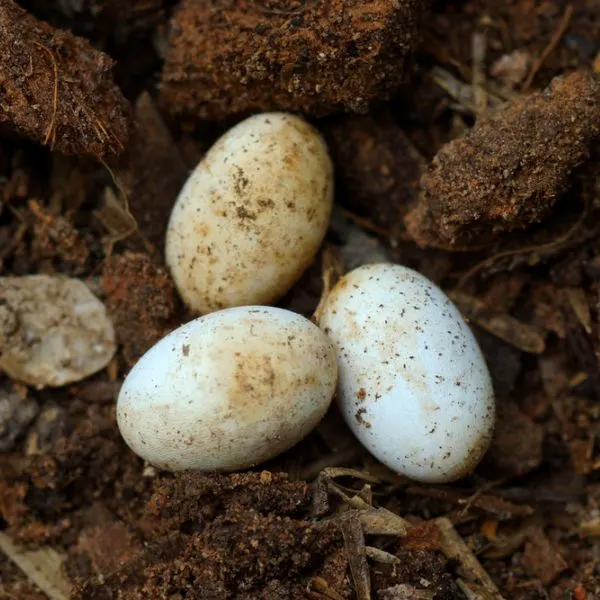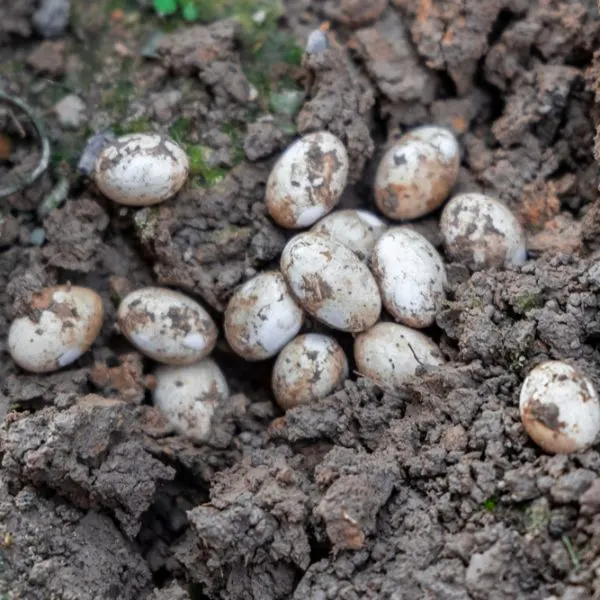Do snakes lay eggs or give live birth? If snakes lay eggs, then how do they do it? Do young snakes eat their way out of their mother’s belly or come out of their mother’s mouth?
Snake reproduction is a fascinating subject that’s filled with lots of speculation. That’s because despite how well-known (and sometimes feared) these slithering reptiles are, how they give birth is still a mystery to many people.
One reason there’s such confusion about how snakes reproduce is that unlike many animals we know, the reproductive openings of snakes aren’t clearly visible. So some people assume these orifices simply don’t exist. But they do, and snakes use them.
On the subject of whether snakes lay eggs or give live birth, it depends. Snakes are fans of both reproductive strategies. Most snakes lay eggs, while others give birth to their young alive.
In this article, we’ll be discussing egg-laying (oviparous) snakes in detail, from how snakes lay eggs to why some species lay eggs and others don’t. We’ll also dispel some common myths about snake reproduction.
Table of Contents
So, how do snakes lay eggs?
Video of snake laying eggs
Here’s a video showing how a corn snake lays eggs. The mechanism is the same for virtually all egg-laying snakes.
Snakes lay eggs using a special orifice called a cloaca. The cloaca is located at the end of their gut, so you’ll find it on their underside, just before their tail starts. In addition to reproduction, the cloaca is used for mating and the excretion of undigested food.
Though many non-mammals like birds have cloacas, the cloaca of snakes is most similar to those of other reptiles, such as lizards. This multi-purpose orifice is most visible when it opens up.
When pregnant egg-laying snakes are due to lay eggs, they push the eggs along their bodies and out the cloaca by contracting and relaxing their muscles. The cloaca widens to accommodate the circumference of the eggs and closes once all the eggs are out.
Like other animals, snakes sometimes have problems giving birth. The term for this is dystocia, and oviparous snakes experience it when they can’t expel all their eggs from their bodies.
Dystocia may happen because the eggs are too large, awkwardly positioned within the uterus, or due to poor contraction and expansion of the uterine muscles. In some cases, only one or two eggs get stuck. In extreme cases, none of the eggs come out.
Many snakes eventually lay stuck eggs, especially if only a few are stuck. Snakes with too many stuck eggs may die if they can’t pass out stuck eggs in time.
How Many Eggs Does a Snake Lay?
The clutch size (i.e. number of eggs a snake lays at a time) of snakes varies with several factors, such as the snake species and whether or not the environmental conditions are friendly.
Most snakes lay an average of 10 to 30 eggs per clutch. Some snakes lay as few as one or two eggs per clutch, while others lay as many as 100 eggs.
You might think that large snakes have always bigger clutch sizes since their bodies can accommodate more eggs, but this isn’t true. Large snakes don’t necessarily lay more eggs than smaller snakes.
While some large pythons have clutch sizes somewhere around 30 to 100+ eggs, many pythons of similar size lay only about 10 to 30 eggs per clutch. This smaller clutch size is comparable to the average of snakes a fraction of their size.
How Snake Eggs Hatch

Like birds and other reptiles, snake eggs hatch on their own.
Baby snakes emerge from their eggs by tearing the shells open from the inside using an egg tooth. This egg tooth is located in front of their upper lips and is soon lost once external development begins.
Some snakes come out of the eggs immediately after slitting the shells open. Others remain within their eggs for hours before coming out.
How Long Do Snake Eggs Take to Hatch?
The average incubation period for snake eggs is 60 to 70 days.
But some species’ eggs hatch much earlier, while others take considerably longer. How long a snake’s eggs take to hatch depends on how developed the eggs are when the snake lays them.
Most snakes lay their eggs when the embryo has developed up to about 30 percent, so their eggs hatch within or close to the average incubation timeframe of 60 to 70 days.
Some snake species lay their eggs shortly after mating when there’s little embryonic development. Such eggs take longer periods to hatch because the eggs go through most developmental stages outside the body.
Species that lay their eggs near the end of the incubation period record much shorter times before their eggs hatch. In fact, some species, such as the Sahara sand viper, lay eggs only days before they are due to hatch.
Where Snakes Lay Eggs
Where snakes lay eggs depends on the species and the prevalent environmental circumstances. But regardless of the species, most snakes choose to lay eggs in places that provide enough warmth to incubate their eggs.
For most snake species, rock crevices and abandoned animal burrows suffice because of their natural heat. The snakes lay their eggs in these crevices or burrows and leave them to incubate and hatch on their own.
Some snake species lay their eggs in heaps of decaying vegetation or manure. This strategy is effective because a plant or animal matter decay generates enough heat to incubate the eggs.
Species like king cobras build nests out of surrounding leaves, lay their eggs in the center, then stick around the nests until the eggs hatch. They do this to prevent egg-eating predators from consuming their eggs.
Egg-laying in Captivity
Captive snakes often don’t have the luxury of seeking out optimal spots to lay their eggs.
If your snake’s enclosure has crevices or burrows, the snake might lay its eggs in them. Otherwise, egg-laying usually happens anywhere within the snake’s enclosure.
Environmental temperatures can influence the development of snake eggs, so the eggs should be kept within temperatures optimal for embryonic development (78 to 84°F). Sadly, most snakes can’t warm their eggs themselves because they’re cold-blooded.
Instead of raising the temperature of the snake‘s enclosure, most snake keepers collect snake eggs from the parent’s enclosure and keep them in egg incubators until the eggs hatch. Heatable snake racks are also good alternatives.
It’s important to monitor pregnant snakes in captivity while they’re giving birth for any signs of dystocia. If your snake has difficulty passing her eggs, take her to a vet.
Some vets can help such snakes safely lay their eggs.
Some Snakes Can Lay Eggs Without Mating
While most snakes must mate before producing the eggs they lay, some snake species can lay viable eggs without mating. This process, called parthenogenesis, involves a female snake making exact clones of herself without male sperm.
There are two types of parthenogenesis in snakes. Facultative parthenogenesis is the more common type, and it involves ordinarily bisexual species like pythons reproducing asexually as a last resort when males aren’t available.
Obligate parthenogenesis involves asexual reproduction as the default or only means of reproduction. While you’ll find many examples of such species among other reptiles, only one known snake species displays obligate parthenogenesis.
This species is called the brahminy blind snake (Indotyphlops braminus). Although originally native to India, this snake species has been introduced to many parts of the world and is now one of the most widespread snake species.
There are no male brahminy blind snakes. All known members of this species are females, and they typically produce about one to six eggs per clutch.
Like other parthenogenetic snakes, the products of this species’ parthenogenesis often have higher mortality rates than regular snake offspring.
One interesting thing about parthenogenetic snakes is that all the offspring they produce this way are of the same sex. With brahminy blind snakes and pythons, all the offspring are females.
But some snake species produce only males via parthenogenesis.
How to Identify a Snake Egg

You can identify most snake eggs from their appearance and texture. Snake eggs are typically longer than they are wide. They may be oblong or oval, but the two ends are usually blunt.
Snake eggs are typically white or off-white (and less commonly beige) in color, and they have a soft, leathery feel when you touch them. While you might come across some snake eggs that aren’t either color, most of such eggs aren’t viable.
While some snake eggs are large, you can’t always identify snake eggs by their size.
Snake Eggs vs. Lizard Eggs

Snakes and lizards are both reptiles, and the eggs of both animals have many similarities. For example, both snake and lizard eggs are often whitish and covered in soft shells.
One of the best ways to tell a snake’s egg apart from a lizard’s egg is to examine its size. Lizard eggs are usually small and less than or only a little over an inch, while snakes have larger eggs that may be up to five inches long.
Since size alone isn’t a foolproof means of identification, it helps to consider other factors like the egg’s location. Lizards often bury their eggs in moist soil, while snakes mostly lay eggs in rock crevices, vegetation, and animal burrows.
Snake Eggs vs. Bird Eggs

It’s easier to tell snake eggs apart from bird eggs than it is to differentiate snake eggs from those of other reptiles.
The first noticeable difference is that bird eggs are typically very oval and more pointed on one end, while those of snakes aren’t. In addition, bird eggs may have patches of several colors that aren’t white or off-white, while snake eggs rarely do.
If you’re in a position to touch them, you’ll also notice that the shells of snakes and birds are very different. While bird eggs have hard shells, the shell of snake eggs is soft and leathery to the touch.
How to Tell Which Species a Snake Egg Belongs to
You can’t. In most cases, at least. While identifying snake eggs is somewhat easy, narrowing down the species an egg belongs to is difficult. The snake eggs of many different species look virtually the same.
With the exception of a few species that lay eggs with ridged shells or other slight modifications, all snake eggs are longer than wide, leathery-shelled, white, off-white, or beige.
Unless the eggs hatch or you come across the mother hanging around the eggs, it’s usually impossible to know what species is inside the eggs.
What to Do if You Find Snake Eggs

The best thing to do when you encounter snake eggs is to leave them alone, except if you find these eggs near your home or in places you don’t want snakes hanging around.
It’s best not to remove snake eggs yourself, especially if you’re not an expert on snakes because it can be risky. It’s hard to tell if the species within the eggs is dangerous or not.
If the species is dangerous and its parent is nearby, she might attack you.
How Do Snakes Care for Their Eggs?
Most snakes don’t. Pregnant snakes typically look for warm, undisturbed places to lay their eggs and then leave them alone. When the eggs hatch, the young snakes fend for themselves and go on to live their own lives.
Some snakes stay behind after laying eggs to care for and protect their eggs from potential predators. Some serpents, like king cobras (males and females), are more protective when they stick around their eggs.
Many large, oviparous snakes like pythons coil around their eggs, not just to protect them from predators, but to also provide heat for incubation. Since all snakes are cold-blooded, pythons generate heat by shivering around their eggs, almost non-stop.
As the muscles of these pythons rhythmically contract and relax, the temperature around the eggs rises. This process of thermogenesis keeps the temperature around the eggs around 88 to 91°F, which is great for embryonic development.
Oviparity vs. Ovoviviparity vs. Viviparity
These three terms are often used when discussing snakes that lay eggs and those that don’t, sometimes causing confusion. Of these three terms, oviparity and viviparity are the easiest to differentiate.
Oviparous snakes are snakes that lay eggs, while viviparous snakes give birth to their young alive. In viviparous snakes, embryonic development completes inside the mother’s body, and eggs aren’t involved in the process.
Ovoviviparous snakes act as a bridge between both methods of reproduction. Although ovoviviparous snakes also give live birth, their young are born from eggs that hatch inside the mother (as opposed to outside in the case of oviparous snakes).
Why Some Snakes Lay Eggs and Others Don’t
Evolution is the main reason for this difference. Egg-laying is the default or primitive condition in about 70 percent of snakes, while live-bearing is more common among relatively less primitive snakes.
While there are some challenges with sticking to the primitive method of laying eggs, it also has some benefits.
Challenges associated with egg-laying among snakes
The biggest problem oviparous snakes face is finding a good place to lay their eggs. Since snake eggs are still undergoing embryonic development, pregnant snakes have to find spots with enough heat to support this development until the eggs hatch.
Once laid, snakes can’t move their eggs about. Snake eggs are vulnerable to cold, and most snakes can’t warm the eggs themselves. So if temperatures drop too much, or the eggs become exposed where they are hidden, they might not hatch.
Besides environmental factors, eggs are also vulnerable to attack. Most snakes leave their eggs unattended after laying them, leaving their eggs at the mercy of egg-eating predators that discover them.
As discussed before, dystocia is another problem oviparous snakes experience. But it isn’t a challenge uniquely associated with egg-laying. Many live-bearing snakes also experience it.
Pros of egg-laying
Pregnant live-bearing snakes carry all their young inside their bodies until their babies are ready to come out. If they get killed before giving birth, all their young die with them. Oviparous snakes lack this problem.
Oviparous snakes are pregnant for much shorter periods. Once they’ve laid their eggs in secure locations, their reproductive investment is insured against whatever harm comes to them.
Another benefit of egg-laying is that oviparous snakes can quickly get back to their lives and begin hunting again after laying eggs. This is especially true in the tropics, where temperatures rarely get cold enough to interrupt the lives of snakes and their eggs.
Which Snakes Lay Eggs?
Many snake families include both oviparous and live-bearing species, so it’s difficult to make generalizations about egg-laying snakes. However, all blind snakes and most colubrids and elapids lay eggs.
Here are some common snakes that lay eggs:
- King cobras
- Rat snakes
- Worm snakes
- Coral snakes
- Patchnose snakes
- Corn snakes
- Grass snakes
- Green snakes
- Hognose snakes
- Pythons
Frequently Asked Questions
Where do snake eggs come out from?
Snake eggs come out of the snake’s cloaca, a cavity located under the snake’s body. The cloaca opens outside near where the tail starts, and it’s most visible when eggs come out of it.
How often do snakes lay eggs?
Most snakes lay eggs once a year, but some species lay eggs twice a year. Many snakes breed between June and September and hibernate during winter in cold regions. In the tropics, many snakes breed year-round.
Can you interbreed egg-laying and live-bearing snakes?
No, you can’t interbreed egg-laying and live-bearing snakes. Besides how difficult it would be to get them to mate, both snakes can’t produce any offspring.
Do snakes have to mate to lay eggs?
In most cases, yes. Virtually all snakes mate before laying eggs. However, there are some snake species that can lay eggs without first mating. This process is called parthenogenesis, and the snake reproduces exact copies of itself.
Do snakes eat their own eggs?
Snakes don’t usually eat their own eggs, especially because most snakes abandon their eggs shortly after laying them. However, snakes can and often eat the eggs of other snakes and reptiles that they prey on.
How many snakes are in one egg?
There’s only one snake in each snake egg.
What does snake clutch size mean?
The clutch size is the number of eggs snakes lay in a single brooding period or egg-laying event. A clutch refers to a collection of eggs laid at the same time. So if a snake lays 20 eggs at once, it has a clutch size of 20 or 20 eggs in its clutch.
Here are some questions people often have about how snakes lay eggs and snake reproduction in general.
Wrapping up
Most snakes you’ll encounter are egg-laying species, especially the nonvenomous ones. Although there are many myths about how these snakes lay eggs, the process isn’t as complicated as it’s often made to seem.
Snakes lay legs once or twice every year and do so in burrows or crevices with warm temperatures. After passing their eggs out of their cloacas, most snakes abandon the eggs and whatever babies hatch from them. Only a few species hang around their eggs.
If you come across gravid snakes or snake eggs in the wild, it’s best to leave them be. But if you’re dealing with your own snakes, keeping the eggs in an incubator aids embryonic development and can help the eggs hatch without problems.
Sources:
The Book of Snakes by Mark O’Shea
https://nationalzoo.si.edu/animals/king-cobra
https://www.journals.uchicago.edu/doi/abs/10.1086/282299
http://www.northeastparc.org/products/riskassesspdfs/squamata/BreedSeason_squamates.pdf
